WHEN I MET THE CODE TALKERS
(L TO R) Keith Little, Albert Smith, James Nakhai, George Kirk.
NAVAJO NATION - Four old men stood before me in a room filled with photos and trophies. It was January, but the men wore summer colors and turquoise necklaces. Some had medals but most were dressed as if they were Rotary Club members rather than the Navajo Code Talkers.
The year was 1993, a decade before Americans began thanking everyone in uniform “for your service.” And here were heroes who had come home anonymous, unnoticed, who had to be coaxed into an interview. And here I was, holding a notebook, camera, and fears of saying something wrong and silencing the talkers now so reluctant to talk.
They gave their names. Albert Smith. Keith Little. James Nakhai. George Kirk. Then we sat and began our journey back fifty years.
I had read of their exploits. How they transcended the bitterness of the forced relocation that the Navajo call the Long Walk, and enlisted. How they turned Navajo into a code, naming airplanes for birds, ships for fish. How, as one officer recalled, "without the Navajos the Marines would never have taken Iwo Jima." What I did not know was how Navajo tradition discourages talk of military glory. I learned that on the job.
The Navajo code, never broken, was only declassified in 1968, when Vietnam left America in no mood to celebrate soldiers. President Reagan honored the Code Talkers but a decade later, they were scarcely household words. When I pitched their story to Smithsonian, no one at the magazine had heard of them.
“Where did you learn about these guys?” an editor asked me.
“Well,” I said, “I was in a Burger King in Chinle, Arizona. . .” Heading for Colorado, we had stopped in Chinle, in the Navajo Nation. Burger King displayed a local newspaper article. End of story. Get to work.
Reaching across cultures and borders, I began searching for Code Talkers to talk in person. E-mail was rare back then, so I wrote to the Navajo Code Talkers Association in Gallup, New Mexico. And waited. And waited. Six weeks later, I began calling, leaving messages, calling again. When I had almost given up, a grizzled voice was on the line.
Albert Smith was president of the Code Talkers Association. “Well, I don’t know. . . The men didn’t like to brag. . . Well, I don’t know. . .” But maybe if I could get out there in January, he could round up a few.
Two weeks later, I was driving on I40 out of Flagstaff, eastbound. Skirting the Painted Desert, glazed with snow in January, I crossed the New Mexico line and found the address. Led inside by a secretary, I met the men. We spoke about my trip. Easy drive. Thanks so much for —
Keith Little, a hulking man with a soft voice, interrupted. He wanted me to know why it had been so hard to get anyone to talk. Returning from combat, he said, all Navajo had gone through a ceremony called the “Enemy Way,” designed to heal embattled spirits. To speak again was to relive the horrors and to defy a warrior’s tradition of silence. A few men, however, couldn’t resist “spouting off.” Whenever anything appeared in the press, Little said, it caused dissent in the group.
I said I hoped my article wouldn’t cause dissention
“It will,” Little said, but we pressed on. And then, as if borders had opened, they began to talk. Little spoke of a boarding school in Ganado, Arizona, Sunday morning, December 7, 1941. . .
“Me and a bunch of guys were out hunting rabbits with a .22. We had a rabbit cooking down in the wash, and somebody went to the dorm, came back and said, ‘Hey, Pearl Harbor was bombed!’”
After one boy explained where Pearl Harbor was, another asked, “Who did it?”
“Japan.”
“Why’d they do it?”
“They hate Americans.”
“Us, too?”
“Yeah, us too.”
“Then and there,” Little told me, “we all made a promise. We promised each other we’d go after the Japanese instead of hunting rabbits.”
On the stories went. Of why they fought for a nation that had all but erased their nation. “What happened to the Navajo were social conflicts,” Albert Smith said. “But this conflict involved Mother Earth being dominated by foreign countries. It was our responsibility to defend her.”
They spoke of seeing bodies wash ashore — on Guadalcanal, Saipan, Guam, Iwo. James Nakhai told me of a Code Talker captured and tortured by the Japanese. George Kirk showed me a photo of himself, baby-faced, holding a helmet with a hole clean through. “Shrapnel,” he said. He didn’t say more.
They sat for a picture, old men refusing to fade away as Douglas MacArthur said of old soldiers. I said I’d send them the article, but they didn’t seem to care. They wished me a safe trip home.
A light snow was falling as I bid goodbye. The men melted into the New Mexico desert and I headed to Window Rock, capital of the Navajo Nation. At an elementary school students told me about the Code Talkers.
“Are they heroes?” teacher Isidore Begay asked his fourth-graders.
Heads nodded. “We could have lost the war. Then we’d be slaves to Japan.”
My article came out in Smithsonian that August. I sent copies to the Navajo Code Talkers Association, but I never heard a word. In the decade that followed, the Code Talkers were portrayed in a Hollywood movie. Their story was told on PBS and the History Channel. Each Code Talker’s death made news. They were honored by presidents, the Pentagon, and in a dozen books.
The last original Code Talker died in 2014, but ceremonies continue. Whenever I see more celebration, I remember something Keith Little told me. “Most of us are common men. We don’t get in the front line and wave our arms. We know what we did and can tell it as it was without having to wave it on a TV screen.”












